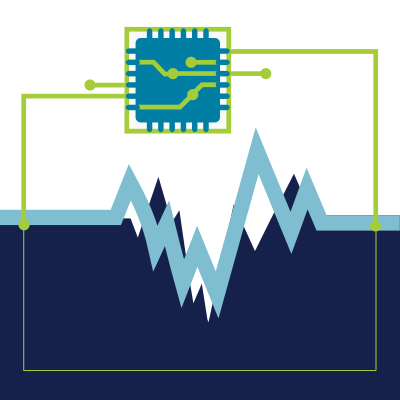
In recent years we have witnessed a paradigm shift toward a more data-centred world. Such increased dependence on information and communications technology (ICT) has permeated many aspects of society including critical infrastructure. The smart grid represents one of the most significant critical infrastructures that facilitates the generation, transmission and distribution of electric power enabling greater robustness, consumer-centricity, efficiency and sustainability by facilitating both bidirectional energy and data flow. Every household will soon be able to actively contribute to the power supply of the grid and make intelligent decisions on scheduling their energy needs based on information from power utilities. The widespread integration of renewable energy sources will enable a vital reduction in our carbon footprint.
The emergence of Internet of Things (IoT), and smart connected devices further underscores the critical interdependencies that exist in this brave new data-centric world. This shift in dependence on ICT, however, has alarmingly increased the cyberattack surface of the smart grid making it more vulnerable to and a greater target of cyber-physical attacks. The Kundur group has engaged in smart grid and cyber-physical security research for over a decade. Research focuses on the development of novel frameworks for modeling and analysis of cyber-physical vulnerabilities, attacks and mitigation schemes using a variety of tools including machine learning, dynamical systems, convex optimization, complex network theory and control. Current research investigates approaches to systematically design intelligent, adaptive, secure and resilient techniques, mechanisms and protocols that merge sophistication with interpretability for the electric grid of the future. More specifically, we address data-driven (e.g., deep learning, AI-inspired) cyber-physical approaches for enhanced situational awareness and effective detection, characterization and reaction to cyberattacks.
Our research thrusts include 1) approaches to enhance the cyber-resilience of adaptive protection, one of the most critical elements of the modern power grid; 2) dynamic routing and on-demand resource allocation in programmable networks such as software-defined networking for enhanced cyberattack mitigation; and 3) increasing the security of smart grid machine learning systems that are targets of adversarial attacks to disrupt intelligent decision-making.
Adaptive protection: As our electric grid grows in complexity, protection schemes that maintain power grid security and reliability must become smarter. Traditional protection schemes are being replaced with advanced algorithms that monitor data from geographically distant locations of the grid to make optimal and accurate protection decisions in real-time. These protection schemes will have to be highly adaptive to account for the proliferation of microgrids, renewable energy integration, and load and transportation electrification. Our research focuses on data-driven approaches to enhance the intelligence, robustness, reliability and security of these critical protection systems. Cyberattacks could have a dramatic impact on power systems that could eventually lead to extended blackout and threaten the stability of our society if they can be launched against the protection system. In the Kundur group, we utilize machine learning-based autoencoders, long short-term memory (LSTM) neural networks and reinforcement learning approaches to build anomaly-based intrusion detection for such critical protection systems in which the amount of data is beyond human supervision. Anomaly-based intrusion detection systems (IDS) are developed to detect malicious behavior in the power grid to prevent widespread blackouts.
Software-defined networking: The emergence of IoT, and smart connected devices will make the smart grid operation critically dependent on the underlying communication infrastructure. For that reason, it is imperative to develop secure and flexible ICT since cyberattacks have the potential for dramatic negative impacts on power systems eventually leading to extended blackout threatening the welfare of society. We investigate programmable networks such as software-defined networking (SDN) as a potential solution for future smart grid ICT as it enables dynamic routing and on-demand resource allocation. SDN infrastructure is a popular topic in today’s research as it brings many opportunities but also challenges for future smart grid applications. At the Kundur group we have developed a comprehensive cyber-physical co-simulator to model the dynamic interactions of the power grid, ICT and computing and control elements by leveraging Riverbed Modeler and OPAL-RT. A real SDN controller, Opendaylight, is integrated to enable SDN capabilities. Our research leverages this extensive modeling platform to empirically investigate the performance of SDN-based networks and the impacts on the physical electricity grid in the face of cyberattacks in comparison to legacy networks. Proactive and reactive modes of operation for SDN are investigated for local area networks and wide area networks. Scalability and other performance issues of paramount interest to smart grid applications are also under investigation.
Security of smart grid machine learning: Advancements in machine learning algorithms, software, hardware and their co-design have enabled a growing penetration of data-driven approaches for smart grid analytics. Deep learning approaches are being poised for sophisticated grid decision-making such as for cybersecurity functions including anomaly detection in IT/OT converged big data environments. However, given their criticality, machine learning models themselves are targets of cyberattacks. Machine learning models have been shown to be vulnerable to data poisoning, backdoor, and adversarial sample generation attacks that target model integrity. Other attacks, including model extraction and membership inference violate model confidentiality. Our research focuses on designing attack scenarios in which the attacker targets the machine learning based, anomaly detection models applied in a power system. An attacker’s knowledge can vary from not knowing the model parameters (known as a black-box attack) to perfect knowledge (called the white-box attack). We develop methods to improve security of anomaly detection models by implementing defensive approaches. For example, given that adversarial sample generation is one possible attack, we identify effective adversarial samples in the context of smart grid, and then develop, implement and test the use of adversarial training to improve security. We focus on the use of generative adversarial networks (GANs) to produce candidate adversarial samples for novel deep learning-based anomaly detection.




